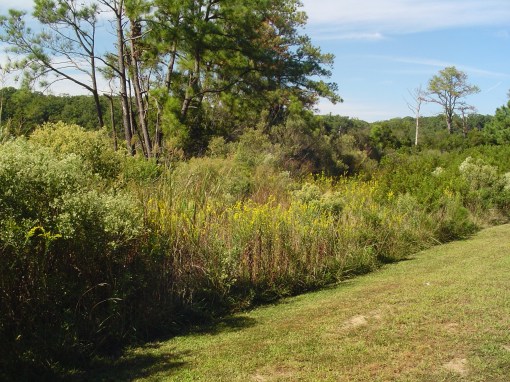~
Goldenrod is one of the last perennial wildflowers to paint the landscape each autumn.
~
~
Beginning its show in early August, Goldenrod keeps blooming up until frost. Native on several continents, including North America, Goldenrod, Solidago species, were popular in English and other European gardens long before they became used as ornamental plants in American gardens in the 1980s.
~
~
Here in Virginia, Goldenrod were considered pretty weeds, found mostly in fields and along the roadside.
Some gardeners still shy away from them, believing that they aggravate fall allergies. This is now considered a myth. Ragweed, also blooming now, is the main culprit for most allergy sufferers.
~
~
In addition to being a beautiful plant, tough and deer resistant, Goldenrod has been used medicinally for centuries. Native Americans chewed the root for toothache and chewed the leaves to treat sore throat. Europeans have made preparations to aid with kidney stones. The leaves, properly prepared, are anti-bacterial. The leaves and seeds are edible. Honey made principally from Goldenrod is especially prized.
Goldenrod is considered a sign or good luck and good fortune. It is the state flower or wildflower in Nebraska, Kentucky, South Carolina, and is the state herb in Delaware.
~
~
Goldenrod grows best in full sun. It is tolerant of a variety of soils, but likes steady moisture. It is perennial and spreads by rhizomes as well as seeds. It is an important food source for many nectar loving insects, and is especially popular with migrating butterflies, and with bees who need a supply of nectar after most flowers have finished for the year.
~

My friend grows several species of Goldenrod and sunflower in her garden on the banks of College Creek. Deer and squirrels are a constant presence, so the flowers and shrubs which succeed here must be tough.
~
Goldenrod is an herbaceous perennial, and so dies back to the ground after heavy frost. It returns each summer, ready for its annual golden show throughout late summer and autumn.
~
~
Many species, and a few hybrids, are now available in the nursery trade. “Fireworks” is especially pretty. Like most perennials, Goldenrod can become invasive.
For those who have difficulty growing many flowering plants because of deer grazing and poor soil, Goldenrod is a tough, reliable choice which gives many weeks of beautiful flowers.
All photos by Woodland Gnome 2013
~
Related articles
- Goldenrod, A Great Pollinator Plant (blogs.mcall.com)
- Sunflowers and Goldenrod (mjnicole.wordpress.com)
- Goldenrod is here (flowerwalks.wordpress.com)
- Got hay fever? Don’t blame goldenrod (miamiherald.com)
- Nature’s Garden (philadelphia.cbslocal.com)







Pingback: Cacalia atriplicifolia | Find Me A Cure
Yes, many people think that goldenrod and rag weed are the same, your photos are so pretty, Annie
Thanks, Annie. I’m one of those who is still skeptical… have always looked askance at Goldenrod. No sneezing after spending several hours photographing it over the last several days, and sitting with my friend in her garden. 😉 We’re never too old to learn something new….
I’ve noticed several different species of Goldenrod growing in my area, there is a smaller variety that has flowers along a single stem, it seems to flower later than the others. In my garden, I dig them up from the flower bed and move them to the spots where nothing much will grow and they do fine. Although this year, my husband asked my son to tidy up the area & they were cut down! No flowers this year, but they’ll be back next year.
What is the difference between a wildflower and a weed? Am so sorry your son didn’t recognize them for flowers before they bloomed. Ageratum is much like that- you have to look for it so it doesn’t get weed-wacked earlier in the season along with the weeds coming along. At least they will be back next year. I’d love to see a photo of your goldenrod if you have one from another year. Thank you for taking time to visit my page tonight-
Cheers! WG